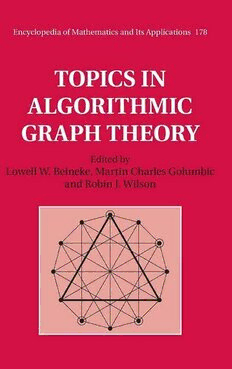
Topics in Algorithmic Graph Theory PDF
Preview Topics in Algorithmic Graph Theory
Foreword MartinCharlesGolumbic Algorithmic graph theory as a discipline began to develop in the mid-1960s, as computer science began to impact research in optimization, operations research and discrete mathematics. Traditional applications of graph theory expanded their focus from engineering, circuit design and communication networks to new areas such as software development, compilers and bioinformatics. In March 1970 the combinatoricscommunityhelditsfirst‘SoutheasternConferenceonCombinatorics, GraphTheory,andComputing’attheUniversityofLouisianainBatonRouge,USA, alternatingformanyyearswithFloridaAtlanticUniversityinBocaRaton,itshome for the past several decades. This was soon followed by the ‘Workshop on Graph- TheoreticConceptsinComputerScience’,foundedin1975andheldinEuropeeach year.Bothoftheseflagshipconferencesareflourishingtoday,togetherwithdozens ofothersthroughouttheacademicworld. As a graduate student in mathematics with a keen interest in computer science, I attended the ‘Complexity of Computer Computations’ symposium organized by RayMillerandJimThatcheratIBMResearchatYorktownHeightsin1972.Itwas veryexciting!Atthefirstcoffeebreak,IintroducedmyselftoStonyBrookprofessor Charles Fiduccia and learned, for the first time, that two n × n matrices can be multipliedusingO(n2.81)arithmeticoperationsinsteadoftheusualO(n3)-algorithm. ‘Really?’, I asked. ‘Yes, see that fellow over there?’, pointing to Volker Strassen. ‘Hedidit!’. The symposium helped to shape my view and interests in discrete applied math- ematics and algorithmic graph theory, stressing the importance of designing novel datastructurestoimplementcombinatorialalgorithms.Thespeakersatthismeeting have become legendary figures in computational complexity, and the diversity of topics emphasized the breadth of research already taking place in mathematics and computerscience.VolkerStrassen’slecturewasonevaluatingrationalfunctions,and ShmuelWinograd’swasaboutparalleliterationmethods.ChuckFiducciaspokeabout upper bounds on the complexity of matrix multiplication, and Ed Reingold gave simpleproofsoflowerboundsforpolynomialevaluation.MichaelRabinpresented workonsolvinglinearequationsbymeansofscalarproducts,andMichaelPaterson lectured on efficient iterations for algebraic numbers. Michael J. Fischer spoke
